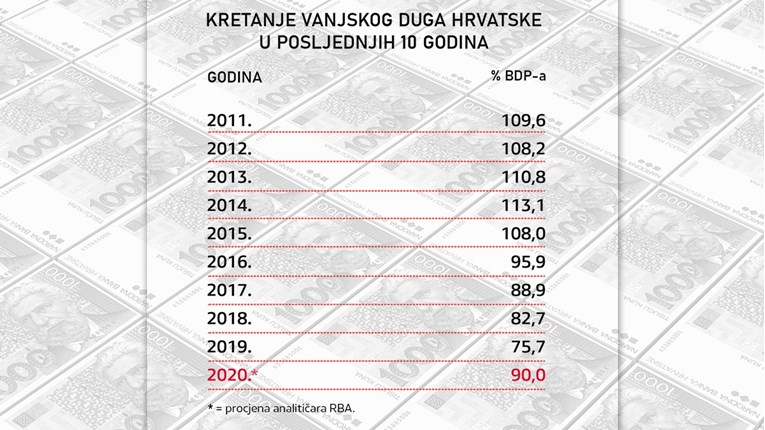Croatia faces a massive increase in its external debt: What do the economists say?

AFTER four years of external debt reduction, Croatia will face an explosion of borrowing in the foreign market this year.
According to Raiffeisen analysts, Croatia might end this year with an external debt of about 90 percent of its gross domestic product (GDP), which brings us back to the 2017 debt level when it comes to our total external debt. The increase in external debt will be a consequence of the crisis caused by the coronavirus and the lack of money in virtually all sectors of the society and the economy, where said lack of money will be covered by borrowing in foreign markets. Therefore, it can be said that the corona crisis will erase the progress made when it comes to reducing the country's external debt in recent years.
The main source of the country's new debt will be companies
The economists believe that the main source of said increase in external debt this year will be companies. The two-month lock-down has left most companies without any revenue, and the recession we are sinking into will further reduce the revenue of most Croatian companies.
"Some companies will try to solve the lack of liquidity and avoid bankruptcy by borrowing abroad. It is clear that some companies will need loans to survive this situation," said Maruska Vizek from the Zagreb Institute of Economics.
However, she adds, borrowing abroad is limited to larger, well-known companies, while the smaller ones generally do not have that opportunity.
The state will also have to borrow, and it is only a matter of when and how much
At this point, it is still not clear how much the government sector will borrow from abroad this year. The final decision on this will have to be made by the new government following the upcoming elections.
However, the two-month "lock-down" of the economy has already significantly reduced the revenue in both the national treasury and in local budgets.
The government may cut public spending, raise taxes, and speed up privatization. There is also the possibility of the government borrowing in the domestic or foreign market.
"The country will have to borrow from abroad, which, in combination with lower GDP, will lead to an increase in the share of external debt in the GDP," warns Vedrana Pribicevic from the Zagreb School of Economics and Management.
What will credit rating agencies say?
According to Pribicevic, the estimate of the increase in external debt to 90 percent of the GDP is realistic, with the possibility of the final share of external debt in the GDP being even larger. Some economists have recently warned that the external debt could approach even 100 percent of the GDP. However, Pribicevic also warns that the country will largely depend on the ratings of credit rating agencies when making decisions on borrowing.
It should be noted that the central bank data show that the growth of the country's external debt started at the beginning of the year, that is, before the outbreak of the coronavirus. At the end of last year, Croatia owed foreign creditors a total of about 40.9 billion euros or 75.7 percent of its GDP. At the end of January, the external debt grew to 41.1 billion euros, which is 0.6 percent more than in December.



 Facebook
Facebook
 Google
Google